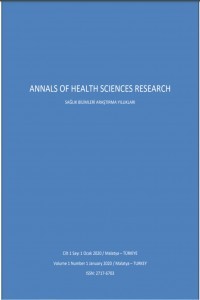Amalgam, Kompozit ve Cam İyonomer Simanların Isı İletkenlik Özelliklerinin İncelenmesi
Amalgam, Cam iyonomer siman, Kompozit, Isı iletimi
Examination of the Heat-Conductive Properties of Amalgams, Composites and Glass Ionomer Cements
Amalgam, Glass ionomer cement, Composite, Heat conductivity,
___
- Hannig M, Bott B. In-vitro pulp chamber temperature polymerization with various light-curing sources. Dent Mater 1999; 15: 275-81. composite resin
- Zach L, Cohen G. Pulp Response to Externally Applied Heat. Oral Surg Oral Med Oral Pathol 1965; 19: 515-30.
- Lin M, Xu F, Lu TJ, Bai BF. A review of heat transfer characterization and mathematical modeling. Dent Mater 2010; 26: 501-13. tooth--experimental
- Çengel YA, Heat Transfer: A Practical Approach, 2nd ed. McGraw-Hill, New York, 2003.
- Saatci B, Marasli N, Gunduz M. Thermal conductivities of solid and liquid phases in Pb-Cd and Sn-Zn binary eutectic alloys. Thermochimica Acta 2007; 454: 128-34.
- Meydaneri F, Saatci B, Ozdemir M. Thermal conductivities solid and liquid phases for pure Al, pure Sn and their binary alloys. Fluid Phase Equilibria 2010; 298: 97-105.
- Garrido PL, Hurtado PI, Nadrowski B. Simple one-dimensional model of heat conduction which obeys fourier’s law. Phys Rev Lett 2001;86:5486- 9.
- Barclay CW, Spence D, Laird WR. Intra-oral temperatures during function. J Oral Rehabil 2005; 32: 886-94.
- Weiner R. Teaching the use of liners, bases, and cements: a 10-year follow-up survey of North American Dental Schools. Dent Today 2006; 25: 74, 76, 78-9; quiz 79.
- Jones CS, Billington RW, Pearson GJ. The effects of lubrication on the temperature rise and surface finish of glass-ionomer cements. J Dent 2006; 34: 602-7.
- Jones CS, Billington RW, Pearson GJ. The effects of lubrication on the temperature rise and surface finish of amalgam and composite resin. J Dent 2007; 35: 36-42.
- Grajower R, Kaufman E, Rajstein J. Temperature in the pulp chamber during polishing of amalgam restorations. J Dent Res 1974; 53: 1189-95.
- Al-Qudah AA, Mitchell CA, Biagioni PA, Hussey DL. contemporary resin-containing dental materials. J Dent 2005; 33: 593-602. investigation of
- Al-Qudah AA, Mitchell CA, Biagioni PA, Hussey DL. Effect of composite shade, increment thickness and curing light on temperature rise during photocuring. J Dent 2007; 35: 238-45.
- Akbulut S, Ocak Y, Keşlioğlu K, Maraşlı N. Thermal conductivities of solid and liquid phases for neopentylglycol, aminomethylpropanediol and their binary alloy. J Phys Chem Solids 2009;70: 72-8.
- Ocak Y, Aksoz S, Maraslı N, Keslioglu K. Experimental conductivity and solid-liquid interfacial energy of solid Ag3Sn intermetallic in the Ag-Sn-In ternary alloy. Intermetallics 2010; 18: 2250-8. thermal
- Little PA, Wood DJ, Bubb NL, Maskill SA, Mair LH, Youngson CC. Thermal conductivity through various restorative lining materials. J Dent 2005; 33: 585-91.
- Panas AJ, Zmuda S, Terpilowski J, Preiskorn M. Investigation of the thermal diffusity of human tooth hard tissue. Int J Thermophys 2003; 24: 837-47.
- Civjan S, Barone JJ, Reinke PE, Selting WJ. Thermal properties of nonmetallic restorative materials. J Dent Res 1972; 51: 1030-7.
- Figueiredo de Magalhaes M, Neto Ferreira RA, Grossi PA, de Andrade RM. Measurement of thermophysical properties of human dentin: effect of open porosity. J Dent 2008; 36: 588-94.
- Tibbetts VR, Schnell RJ, Swartz ML, Philips RW. Thermal diffusion through amalgam and cement base: comparison of in vitro and in vivo measurements. J Dent Res 1976; 55: 441-51.
- Brantley WA, Kerby RE. Thermal diffusivity of glass ionomer cement systems. J Oral Rehabil 1993; 20: 61-8.
- Sweatman TL, Baumgartner JC, Sakaguchi RL. Radicular thermoplasticized gutta-percha. J Endod 2001; 27: 512-5. associated with
- Dominici JT, Clark S, Scheetz J, Eleazer PD. Analysis of heat generation using ultrasonic vibration for post removal. J Endod 2005; 31: 301-3.
- Başlangıç: 2012
- Yayıncı: İnönü Üniversitesi
Rüptüre Kist Hidatik Nedeniyle Gelişen Alerjik Reaksiyon
Mustafa Said AYDOĞAN, Mehmet Ali ERDOĞAN, Ülkü ÖZGÜL, Yusuf Ziya ÇOLAK, Mahmut DURMUŞ
Malatya’da İlköğretim Okulu Öğrencilerinde Şaşılık Sıklığı
Soner DEMİREL, Abuzer GÜNDÜZ, Behice Şuheda DUMAN, Penpegül FIRAT, Sevtap BAKIR, Cengiz YAKINCI
Otoerotizm Kaynaklı Mesane İçinde Yedi Pil
Haluk SÖYLEMEZ, Hakan ÇAKICI, Ahmet Ali SANCAKTUTAR, Murat ATAR, Yaşar BOZKURT
Agresif ve Kronik Periodontitisli Hastalarda Ağız Kokusunun Karşılaştırılması
Abubekir ELTAS, Sinan Eriş YÜCEL
Parmakta Yerleşen Ağrısız Bir Kutanöz Anjioleiomyoma
Nurhan ŞAHİN, Hatice YILMAZ, Emine TÜRKMEN, Feray AYDIN
Biyofilm ve Endodonti: Bölüm 1
Neslihan ŞİMŞEK, Elçin Tekin BULUT
İntihar lı Kalsiyum Kanal Blokeri Zehirlenmesi: Bir Olgu Sunumu
Malatya İlindeki 7-14 Yaş Arası Çocukların Ağız-Diş Sağlığının Değerlendirilmesi
Çiğdem GÜLER, Abubekir ELTAS, Dilek GÜNEŞ, Veli Alper GÖRGEN, Mustafa ERSÖZ
Skrotal Sebase Kistle Karışabilen Nadir Bir Skrotum Hastalığı: İdiyopatik Skrotal Kalsinozis
Ramazan ALTINTAŞ, Fatih OĞUZ, Ali BEYTUR, Serhan ÇİMEN, Ali GÜNEŞ
